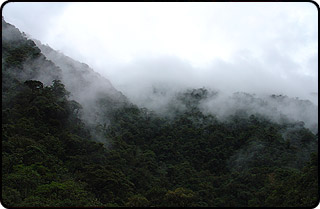Cloud forest plants may not survive unprecedented climate change
 Many species of plants in the Amazon cloud forest may not survive the dramatic climate changes forecast to occur within the next 100 years, according to a new study published in the Feb. 6 issue of Science by Wake Forest University ecologist Miles Silman.
Many species of plants in the Amazon cloud forest may not survive the dramatic climate changes forecast to occur within the next 100 years, according to a new study published in the Feb. 6 issue of Science by Wake Forest University ecologist Miles Silman.
Silman, along with collaborators Mark Bush and Dunia Urrego of the Florida Institute of Technology, documented climate change and changes in forest composition occurring during the past 48,000 years in one of the world’s biodiversity hot spots. It is the first continuous record of Andean climate change.
They took sediment samples from a remote lake on the eastern slope of the Peruvian Andes and analyzed the fossilized pollen in each layer to determine what plants grew in the area and in what abundance from before the peak of the last ice age through modern times.
The data shows that the lower mountain forests of the Andes have a history of profound but not rapid climate change, suggesting that temperature change in these systems was gradual, perhaps averaging less than 1 degree Celsius (approximately 2 degrees Fahrenheit) per 1,000 years, said Silman, assistant professor of biology at Wake Forest. “An anticipated warming of 1 to 4 degrees Celsius within the next 100 years raises concerns for the long-term survival of these systems,” he said.
A 1 degree increase is the minimum estimate made by the International Panel on Climate Change, and predictions made specifically for the eastern Andes show a 2-4 degree Celsius change is likely.
The minimum rate of predicted change would be 10 times greater than the most rapid temperature change that took place in the past 48,000 years.
“For species with narrow elevation ranges, the predicted rate of climate change may move them completely outside of their climatic niche space within only one or two plant generations,” Silman and his co-authors wrote in the study. “Climate change, coupled with habitat destruction, could cause Andean plant communities to experience greatly increased extinction rates.”
“The cloud forests in the eastern Andes and the adjacent Amazon basin have the highest biodiversity of any place in the world,” Silman said. “When we want to understand the impact of climate and climate change on biodiversity this is a critical area.”
 Temperature changes with elevation vary predictably, and plants have limited temperature ranges in which they grow well.
Temperature changes with elevation vary predictably, and plants have limited temperature ranges in which they grow well.
“Just think of the planting zones on the back of a garden seed packet,” Silman said. “In the Andes, all of these zones are compressed down to a few hundred meters wide. I could throw a rock across the elevational range of an entire species. Andean slopes have large numbers of native species with narrow altitudinal distributions and that makes the Andean system especially sensitive to past and present climate change.”
Species in the cloud forest do not have to make large migrations to stay in the climate range that would allow them to survive.
From the data collected, Silman and his fellow researchers determined the cloud forest existed at or near the site consistently for the past 48,000 years. The forests were more stable for longer periods of time than we expected, he said.
Because plant communities form the basis for all other biodiversity in these systems, stability is important.
“When we lose plant species and substantially alter the plant communities in other systems, we get cascading changes in the animal communities, and, importantly, changes in plant communities that can, in turn, cause further changes in climate,” Silman explained.
The area experienced an ice-age cooling of 5 to 9 degrees Celsius (about 9 to 16 degrees Fahrenheit) and then a gradual warming beginning about 19,000 years ago. The warming progressed steadily with no sudden accelerations.
The cloud forest maintained high diversity even after significant climate change, Silman said, but the unprecedented change in climate predicted in the next century could prove too challenging for the plants there.
Maintaining high diversity is important because “a lot of our technology — medicine, agriculture, even cleaning oil spills, is driven by genetic engineering,” Silman said. “We prospect for genes in the environment for all of these things. The Andean biodiversity hot spot is the largest single repository of genetic information on the planet, and we are in danger of what is tantamount to burning the library at Alexandria.”



